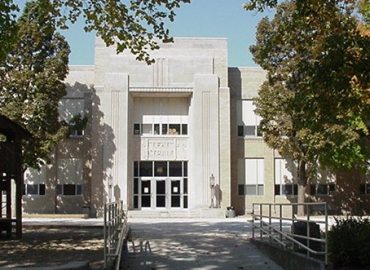 Congregations who are determined to be good stewards of the earth can set a constructive example by adopting smart energy practices. SEDAC can assist in these efforts by identifying energy efficiency strategies best suited to your place of worship, whether your facility is small or large, old or new. The average congregation spends most of its energy dollars on heating, lighting, and cooling. Even small improvements in these areas will yield considerable energy cost savings and increased performance. This fact sheet reviews some common energy savings measures.
Congregations who are determined to be good stewards of the earth can set a constructive example by adopting smart energy practices. SEDAC can assist in these efforts by identifying energy efficiency strategies best suited to your place of worship, whether your facility is small or large, old or new. The average congregation spends most of its energy dollars on heating, lighting, and cooling. Even small improvements in these areas will yield considerable energy cost savings and increased performance. This fact sheet reviews some common energy savings measures.
Where to make changes
SEDAC has analyzed many places of worship throughout Illinois and developed an energy use profile typical for this kind of facility (see pie chart). The average congregation spends most of its energy dollars on heating, lighting, and cooling. Even small improvements in the top three areas of energy usage will yield considerable impacts on energy consumption and performance. An important variable with worship buildings is the number of hours of use. Your facility may only be fully used for six hours on a weekend, and only partially utilized during the week. Or, it may have limited use in all areas of the space all throughout the week.Keep in mind that each energy-saving measure produces different economics, depending on how your facility is used. Compare building hours with equipment operation hours to eliminate off-hour costs. A review of energy-efficient measures can help your congregation prioritize where to start with energy management and stewardship goals.
Get members involved!
Responsibility for improving energy efficiency within your house of worship can be shared throughout the congregation. Post graphs of your utility bills; associate energy costs with a budget percentage. Start an Energy Efficiency Steering Committee. Celebrate successes in decreasing energy costs and improving efficiency. Offer seminars to educate members (and the community) on energy efficiency and environmental consciousness. Some possible topics include:
- Energy Efficiency
- Climate Change
- Smart Meters
- Water Usage
- Renewables
- Local Economies
Smart lighting solutions
A lighting retrofit can be a great place to start; retrofits are simple, quick, and can be launched with low up-front costs. Lighting typically accounts for 24% of congregational energy use, which can be reduced by taking advantage of newer technologies. Here are some opportunities:
- Replacing Florescent T-8 tubes with LED retrofits reduces energy consumption by about 50% and is quick and easy. If you still have outdated T-12 tubes, you can save even more energy by upgrading. Compared with incandescents, LEDs provide 10 times the lumens per watt, use less electricity, and last 10 times longer.
- Replace high intensity discharge (HID) lamps with high bay LEDs. Many options exist that are Plug-and-Play compatible. Ease of installation and substantial energy savings possibility makes this retrofit a quick payoff.
- Retrofit existing exit signs with LEDs if you have not already done so. Each LED sign saves roughly $30/year so it will pay for itself in a year!
- For outdoor areas, use LEDs and install photosensors, timers or astronomical clocks that automatically activate lamps in diminishing daylight then turn off from 1 to 5AM.
- Install occupancy sensors in spaces with frequent periods of extended vacancy such as restrooms, kitchens, and classrooms. Most places of worship have numerous areas that can benefit from occupancy-based lighting.
- Where possible, take advantage of the best and least expensive type of light: Daylight! Consider turning off lights and using task lighting. In sunny areas, install daylight sensors so lights are not inadvertently left on.
Other energy savings recommendations
 Worship sanctuaries. Add padding to chilly seating services and you may experience fewer requests to "turn up the heat."
Worship sanctuaries. Add padding to chilly seating services and you may experience fewer requests to "turn up the heat."- Organs. Consider setbacks for organ spaces. Temperatures can be reduced as low as 40°F without posing a concern; however, excessive seasonal variations in humidity can damage organ components. A humidity gauge (inside the organ) should be monitored.
- Reduce ventilation demands. Consider installing demand-control ventilation, which can either close ventilation at night, or sense CO2 levels and adjust air intake and venting in accordance with fluctuating occupancy demands.
- High ceilings. In a tall sanctuary, the heated air rises to the ceiling, without warming the occupants. One solution: high volume, low speed fans that blow downward. If properly spaced and sized, the fans will properly mix the air. In the summer, take advantage of stratification by not turning on ceiling fans and letting heat rise. Parishioners still too warm? Use floor fans to keep air moving. When installing a cooling system, consider a low-velocity displacement system. This system brings cool air down low—where the people are—and allows hot air to rise. Attic exhaust fans also help remove hot air and improve ventilation.
- Quick fixes. Turn off all power-drawing equipment when not in use and print double sided to reduce energy use. Remember: screen savers waste energy. Roughly half the energy used for personal computers is expended during idle hours. Place monitors and computers into sleep mode when not in use and make use of power management settings on all equipment
How does your congregation stack up?
Benchmarking is the practice of comparing the energy use of buildings of similar function by energy use per square foot. Benchmarking is very useful in identifying opportunities for improvement and prioritizing energy efficiency projects. Schedule a utility bill analysis and/or energy assessment with SEDAC today to see how your building is performing in relation to the majority of other places of worship.







